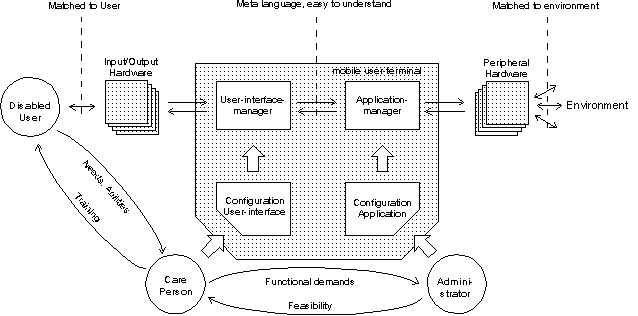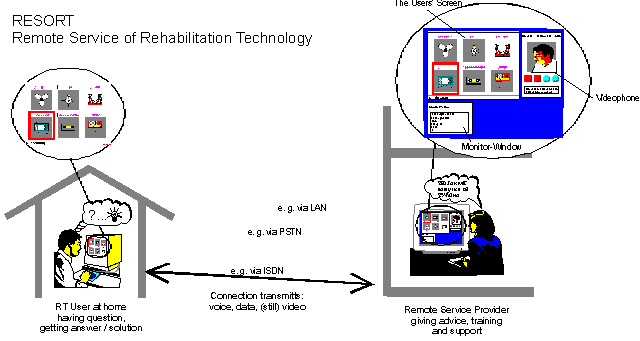Web Posted on: August 24, 1998
Improving PC-Based Assistive Technology by Telematic Service Provision
Wolfgang L. Zagler, Paul Panek
fortec – Research Group on Rehabilitation Technology
Institut für Allgemeine Elektrotechnik und Elektronik
Vienna University of Technology
tel: + 43 1 405-1830/11, fax: + 43 1 504-1830/12
e-mail: zw@fortec.tuwien.ac.at
pp@fortec.tuwien.ac.at
http://fortec.iaee.tuwien.ac.at/fortec
1. Summary
A considerable portion of today's assistive technology products is based on standard or modified personal computer technology. This is especially true for high-end environmental control systems, for AAC and for devices used for therapy and training. Using standard PC technology not only significantly improves the performance and availability of assistive technology but also the value for money relation for the end user. The crucial point for user satisfaction, however, is not only the price for purchasing the equipment but to an even greater extent the cost of personal adaptation and continuous service and updating according to changing user needs.
To keep the costs for service and adaptation low the recently started TIDE project RESORT aims at developing a multimedia link between the RT-user and a service provider. Updating the user software, carrying out adjustments, answering questions of the user and troubleshooting will no longer require the personal presence of a specialist but will be achieved via telematics.
2. PC based rehabilitation technology
Today Rehabilitation Technology devices are increasingly based on standard PC technology. Decreasing costs of PC hardware, the availability of compact and mobile units like notebooks, palmtops or PDAs (Personal Digital Assistant) and the multimedia capabilities are stimulating this trend. Among others PC-based Rehabilitation Technology is used in the following areas:
2.1 Communication aids
Multimedia notebooks and palmtops offer a perfect baseline for the development of communication aids. The goal of communication aids is to augment interpersonal- and telecommunication for persons who, for what reason ever, are not able to communicate in the usual manner. The main reasons for communication disorders are speech and language impairments. Multimedia PC technology offers all the prerequisites for translating between text or symbols on the one hand and pre-recorded or synthesised speech on the other hand.
2.2 Aids for therapy and training
In the area of therapy and training of disabled persons the PC has become a valuable tool in the hands of pedagogues and therapists. The possibility to be able to learn or train almost without any temporal or local restriction and to have a teacher or trainer who's patience never is exhausted are doubtlessly the big advantages of using PCs in this field. However, it never should be forgotten that learning and training is aiming at improvements in the behaviour and abilities of the client. Teaching and training programmes, therefore, must not be a static setting, but carefully have to be adapted to the changing needs by the human professional.
2.3 Environmental control
For severely motor impaired persons the implementation of so called Environmental Control Systems (ECS) can mean all the difference between inability and independent living. The ECS establishes a custom tailored interface between the user's residual abilities and his or her physical environment by providing the possibility to operate electrical appliances, communications devices, doors and windows and a host of other things by remote control. The quality and usability of an ECS is determined mainly by three factors:
a) The versatility and flexibility of the user interface, i.e. is it possible to offer input and output facilities which best match the user's needs and which exploit the user's abilities in an optimum manner?
b) The versatility and flexibility of the application interface, i.e. how easy and efficient can the system be linked to the environment, is it possible to use reasonable priced off-the-shelf products and can expensive modifications in the house (like wiring) be kept to a minimum?
c) The adaptability of the entire system whenever changes in the user's abilities or needs occur, i.e. what are the efforts and costs incurred to update the system and keep it at a level of high user satisfaction and usability?
The first two items of the above list mainly concern the moment of purchasing and installing the system. The third item, however, is important for the entire life-cycle of the product. The easiness and cost-effectiveness of adaptations, which become necessary or desirable after the first set-up of the system, are a crucial factor and call for careful system design.
2.4 Augmented access to PCs
Accessing a user PC via an interface designed for disabled persons can be considered as a special case of an ECS. By emulating the functions of keyboard and mouse the assistive system can make fully accessible any standard PC even for severely impaired persons.
| Top |
3. The AUTONOMY System as an example
The innovative technical assistance system developed at the Vienna University of Technology which we named AUTONOMY not only integrates all the above mentioned functional areas but also tries to offer an optimum in post-installation adaptability [1]. To ensure this it was recognised that there are different groups of users working with the system and that each group deserves a user interface tailored to specific needs and abilities.
3.1 User groups to be addressed
To assist severely impaired persons one must not focus on the disabled user alone but has also to consider the importance of the "facilitators" and the "integrators". We, therefore, have to consider and to serve three groups of users [2]:
*) The end-user (the person with special needs) is using the assistance system in order to overcome barriers imposed by a disability.
*) The facilitator (e.g. a therapist, pedagogue or family member) is responsible for the configuration and permanent adaptation of the user-interface in order to keep the man-machine interface functioning on an optimum level.
*) The integrator (a technician) is carrying out the technical set-up of the system and is responsible for connecting the system to the physical environment.
3.2 The three-interfaces-concept
To support the successful co-operation between these three groups of users AUTONOMY offers three dedicated interfaces/tools: the user-interface, the configuration tool and the set-up/test tool. Figure 1 shows the interaction between the system components and how the different user groups utilise the three user-interfaces. The user-interface-manager and the application-manager are internally linked with one another by an easy to understand meta language. This ensures that, after the integrator has set up the application configuration and the peripheral hardware the facilitator can refer to non-cryptic terms when configuring and maintaining the user-interface.

Fig. 1: Interaction between system components, user interfaces and user groups
| Top |
4. The need for continuous service provision
Field trials using the prototype of AUTONOMY documented the need [3] for continuous service provision. As an example for illustration we now will consider an environmental control system which is used by a severely mobility impaired person for accessing different home appliances:
4.1 Example for the standard service scenario
Let us assume that a severely motor disabled user controls his TV via a single switch interface. By entering the TV-menu of the ECS he is able to switch the TV on and off, to select the channel and to control the volume. Later he decides to have a VCR (Video Cassette Recorder) purchased and integrated into his ECS. AUTONOMY certainly would offer all the tools by which a family member (the facilitator) could add the necessary VCR-commands to the menu structure of the ECS. The installation of additional infrared-codes, however, could be a task which is beyond the capabilities of a non-technician. Calling the "integrator" will be the result.
4.2 Cost factors
Assistive devices are, up to now, not products for a mass market. Therefore, it is unlikely that the "integrator" who is able to make the necessary modifications is living round the corner. Even if the modification is small and will take just a few minutes to be executed, the costs for such a service can be disproportional high due to the time necessary for travelling to the customer's premises. So the likely result will be, that the VCR never is attached to the user's ECS and that the usability of the assistive system is degraded.
| Top |
5. The RESORT approach for telematic service provision
These considerations formed the baseline for the recently started TIDE project RESORT where telematics will be applied to avoid disproportional high costs for simple to carry out service tasks. RESORT – which stands for REmote Service of Rehabilitation Technology – aims at creating a multimedia telematic link between the end-user's PC-based assistive technology system and the service provider. Leaving the hard- and software applications of the end-user more or less unchanged, RESORT will add a remote control interface offering the following features (see also Fig. 2):
*) In the telecommunication mode, RESORT will provide hands-free communication between the user and the service provider. If the available bandwidth is large enough a videophone-link can be established.
*) In the pupil-teacher mode an additional data-link is established. The service provider will load exactly the same RT application as the user is running. The two applications – at the user's site and at the provider's site – will be synchronised via the data link.
*) In the tele-service-mode the service provider will have the possibility to down/upload files from and to the user's PC, modify configurations and test the changes he or she has made.

Fig. 2: Remote service provision for assistive devices
By using RESORT the example scenario in chapter 4 would be quite different. After having purchased the VCR and having it connected to the TV the user himself would call the service provider. Using RESORT's telecommunication mode he will explain the situation and specify the type of VCR. The service provider in turn will prepare the modifications of the user interface and the additional infrared-codes off-line and later download and test the new configuration via the RESORT tele-service-mode. After entering the pupil-teacher-mode the service provider will introduce the user to the new configuration, answer the user's questions and make sure that he new set-up works satisfactorily. Time and costs incurred now are reduced to the necessary technical procedure without any overhead for transport.
RESORT not only aims at technical service but also at pedagogic and therapeutic support via the telematic channel. At the end of the project in early 2000 it is envisaged to invite manufacturers of assistive technology systems to adopt the RESORT protocol for their products in order to strengthen their position in the RT market. Interested parties are invited to watch the progress of RESORT by visiting the RESORT home page: http://fortec.iaee.tuwien.ac.at/resort.html.
| Top |
Literature:
[1] W.L. Zagler, P. Panek, C. Flachberger, "Technical Assistance for Severely Motor- and Multiple Impaired Children", Proc. of the 10th IEEE CBMS Symposium, Maribor, 1997.
[2] P. Fuller, A. Lysley, D. Colven: "Trees in the Forest" or "Seeing the Wood for Trees", in: I. Placencia Porrero, R. Puig de la Bellacasa: "The European Context for Assistive Technology", Proceedings of the 2nd TIDE Congress, Paris 1995, IOS Press, 1995.
[3] P. Panek, C. Flachberger, W.L. Zagler, "The Integration of Technical Assistance into the Rehabilitation Process - a Field Study", Proc. of the 5th International Conference on Computers for Handicapped Persons (ICCHP), Linz, Austria, July 1996, Oldenbourg 1996.
| Top | | TIDE 98 Papers |
